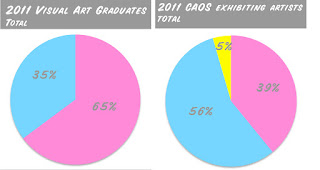Pie I have eaten / Pie I am yet to eat
For a few years now CoUNTess has been keeping tabs on gender representation in the Australian art
world and sharing our findings via this blog. We are pleased that all our number crunching is adding up to something and coming to the
attention of the media and institutions. Renown feminist journalist
Anne Summers new online publication
Anne Summers Report featured a report on CoUNTess on page 11.
And in
The Age Sunday Dec 2nd CoUNTess gets a significant reference in an article by
Fiona Grubber “Recasting the old masters club” pointing out how women working in
Australia’s visual art institutions far outnumber men, yet only a few are
holding the top jobs and nor were credible women candidates touted as even being
in the running for the recent directorial appointments at various state
museums. CoUNTess wonders why the
art world is a place where the majority of administrative, curatorship
and promotion positions at art institutions are filled by women (although as Grubber points out the top job is more often than not a man), but all the while exhibiting in a majority of male artists, CoUNTess believes, at the expense of their female colleagues?
There are a couple of
points in Grubber's article of particular interest to CoUNTess which address the social and economic climate that women artists are working in. The first is in reference to Sydney gallerist Roslyn
Oxley
“she sees
gender bias in the marketplace all the time. Collectors tend to prefer male
artists' work, and among the gallery's stable of mid-career artists, the men's
earning capacity is significantly greater”
This is
interesting because it pinpoints the issue of collector bias as a site of important research for future
attention in the posts of CoUNTess. Anyone who visits art fairs, commercial galleries and auction houses can take note how often the price point for women artists is significantly lower than for work by men.
The second point of interest is her reference to a statistic from the Australia Council, showing
the gender of working artists and how much they earn.
“Being an artist is also twice as tough for
women. Australia Council statistics from 2008 (the most recent available)
reveal that two thirds of visual artists are women but that women in the arts
(there are no separate income figures for visual artists) earn on average 50
per cent less than men.”
One way to influence collector bias is to ensure that public funding of art institutions is shared more equitably. If publicly funded galleries collected and exhibited with female artists with equitable recognition, it would certainly raise these artists' profile and elevate a collectors confidence in buying work by female artists. CoUNTess believes our public galleries should also be taking an interest in collecting and exhibiting art that is representative of what is being produced not just art that is being speculated upon.



















